La Feria the Abril is getting closer and closer, therefore, for everyone who is thinking about going but doesn't know what to wear during those days, here it goes a list of the new 2017 trends, and what you will be able to find in our store of Flamencoexport.
- The urban flamenca style will be a point to highlight this year and it will be seen in all shorts of shirts, jackets, pants, etc.
- The sleeves will be the biggest protagonists this season. This year they have become the main and most important part of the flamenca dresses, and most of them are created in a big size so they are striking and seemed like a distintion sign.
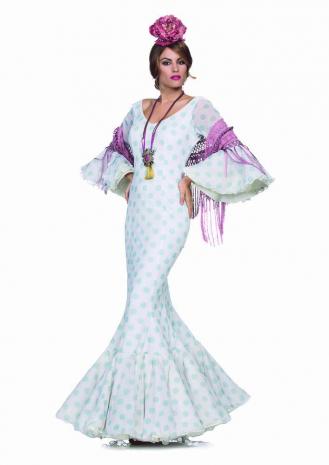
- The polka dots will continue to be an important part of the new dresses, even though this year there will be different combinations of sizes, colours and designs.
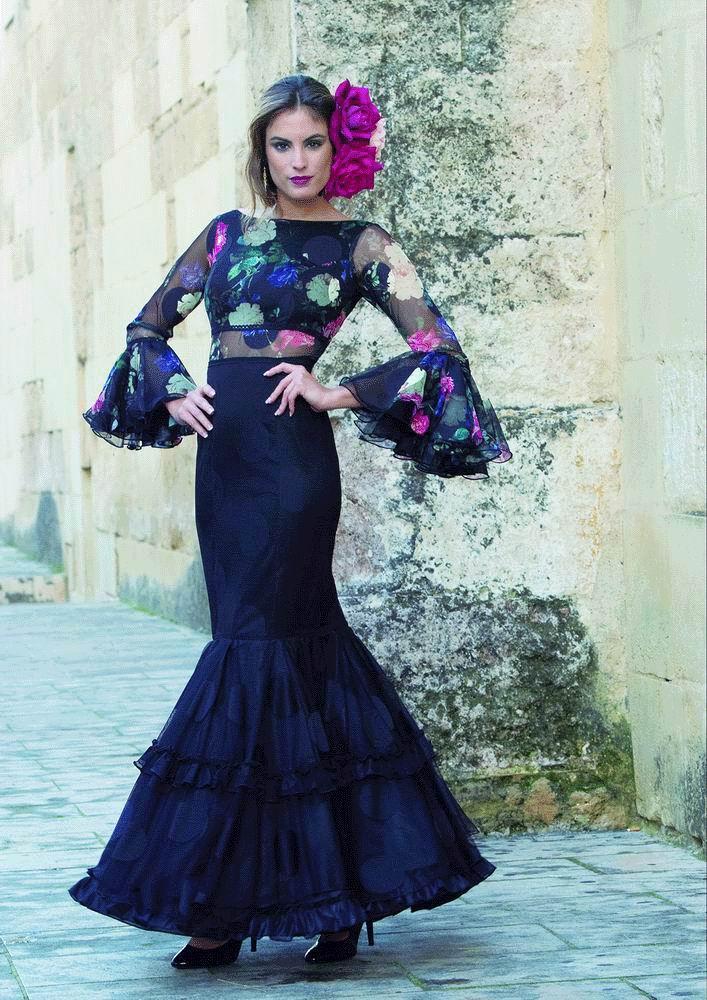
- Blue, mint green and yellow: these will be some of the colours that will stand out this year and will become an alternative of the classic red. Yellow is also specially suitable for tanned people.
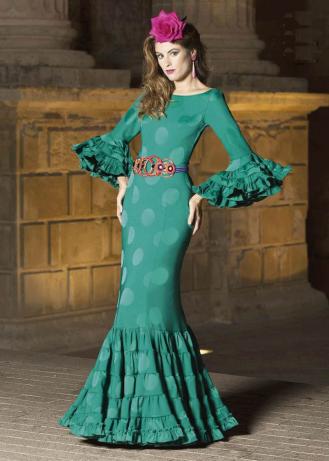
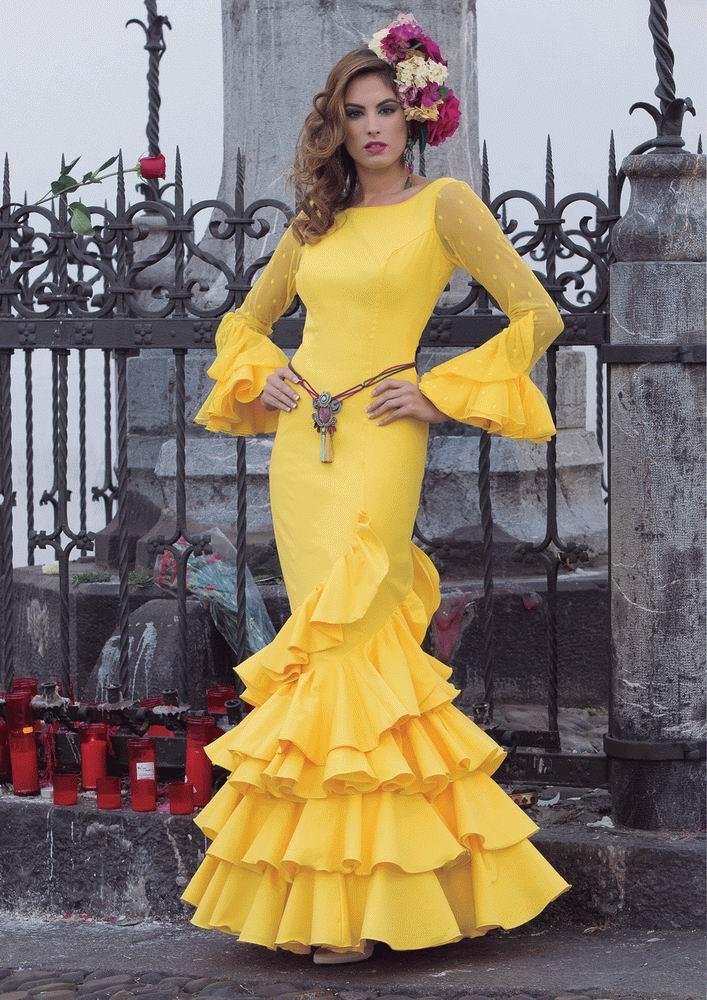
- The floral patterns will become also, this year, one of the most important points. There will be diffent designs with gradients, patterns and colours.
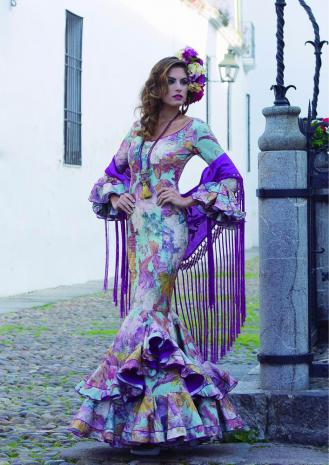
- A high waist line with frills with a big fall will also be relevant factors. Materials like knit fabrics, lycra, silk and gauze will also be used in this types of dresses. Also, some of the dresses will have a lot of volume.
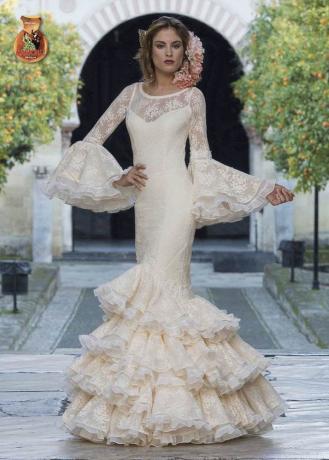
- Fringes will become the main thing this season. They will not be exclusively an element used in accesories, but they will be a very important part of sleeves, shirts, tops and flamenca dresses in general.
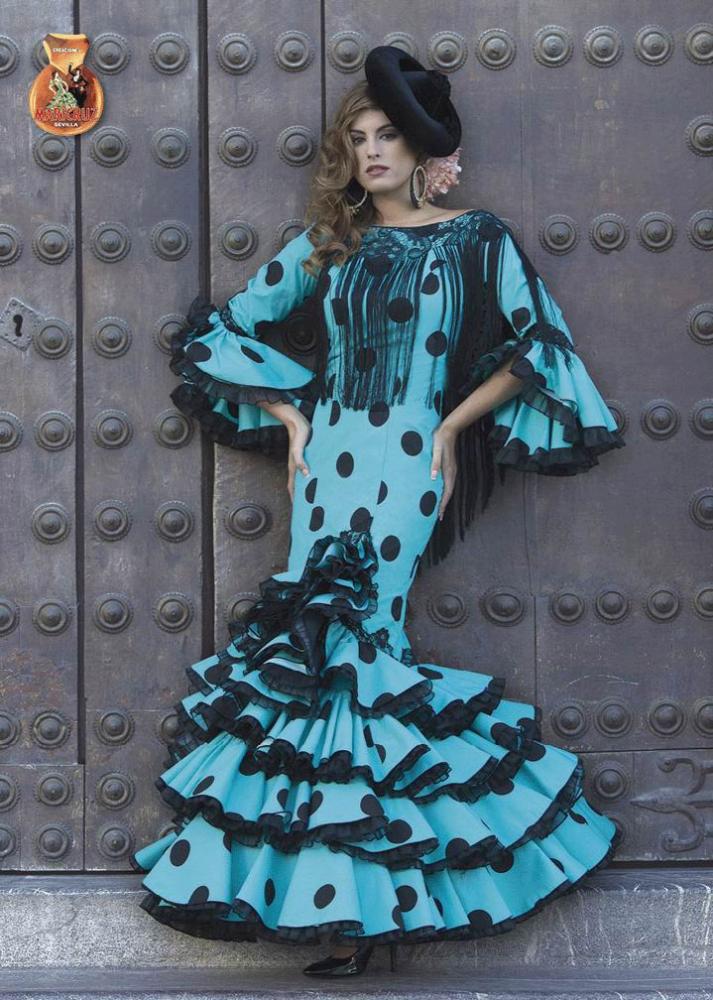
IMPORTANT:
If you are interested in any of our dressses or you are looking for a more economic option you can visit our web page flamencoexport@flamencoexport.com. Also you can check our newest Mari Cruz 2017-2018 colection or search any other options in our outlet section.
A fan is an instrument and a fashion accesory created so that with a rythmic wrist movement it can be easily moved and it can help to cool down the environment. Its origins are believed to be in the East, and its creation is delicate, special when it is made with artistic designs and quality materials. In China it is a millenary tradition, in fact, it goes back to the emperor Hsien Yuan times, around the year 2697 B.C. However, the fans were also used by egipcians, babilonians, persians, greeks and romans. The egipcian fans used to be large, fixed, with a semircircular shape, feathers and long handles. Its function used to be double: to give air and to shoo away the insects. Over time the fans became decorative and an indicative of the power someone had. On the other hand, the romans called it flabelo, and the ones used to scare the insects were called muscaria.
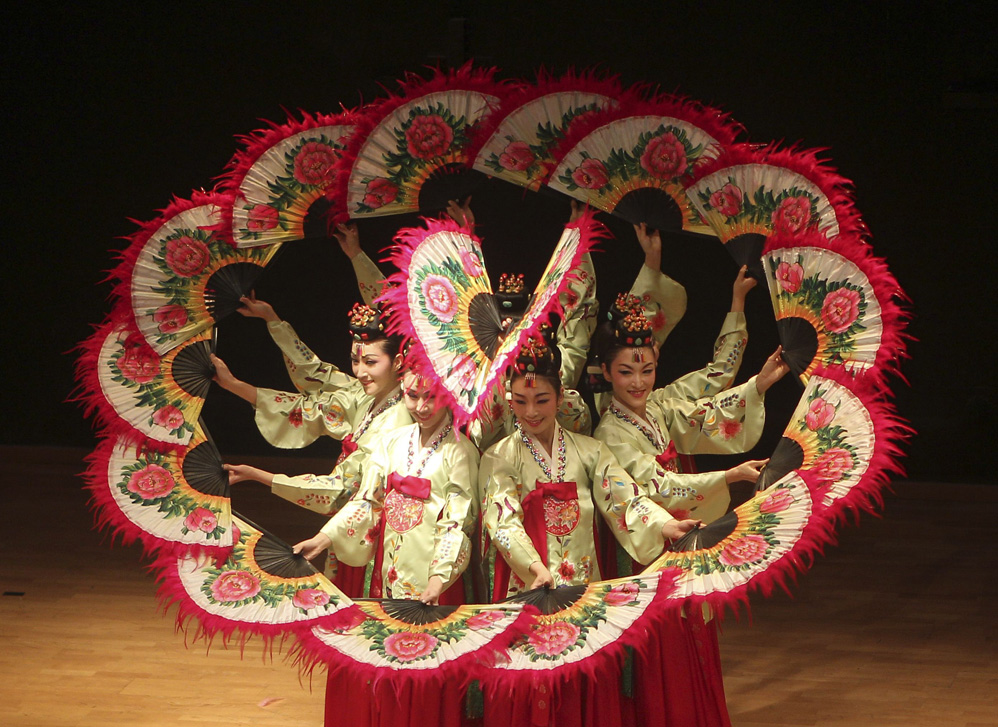
In the East, during the Middle Age, the fan became part of the christian liturgy and was used for the consecration, to protect the Eucharist from the insects and refresh the assistants. After the XIV century it fell into disuse in the roman church, but it was preserved in the greek and armenian churches, where it receives the name of rhipidion. The fan was also known by incas and aztecs, since between the gifts Moctezuma gave to Hernán Cortés there were six feather fans. And nowadays they still made them in different places all over the world, like in Spain, where the fan has become the most characteristic element of our culture and, of course, of the flamenco dance.
Morphology and types of fans
The fans are divided in two parts, the body wich is the area that moves the air and is composed by the linkage and the fabric, and the handle, that allows to manage the instrument with ease.
Fixed fans
This kinds are flat and generally hold by a handle in different sizes. Some of then are symmetric, and have a rounded layer fixed to one end. Other have a cardboard rectangular layer, fixed on one side to a rod that works as a handle. They are made in several materials like carboard, palm tree leafs, fabric or feathers.
Foldable fans
Semircicular fans made with various equal plain rods of wood, ivory or synthetic material, attached at the base with a small nail. The rods are put together on the other side with a wide, normally decorated, piece of fabric or paper. The fan opens in a semicircular shape. This are composed of:
-
Baraja: foldable skeleton of the fan.
-
País (Body): fabric adhered to the skeleton. The fans that don't have this part are denominated just baraja.
-
Varillas (Rods): drawn or painted wooden strips. There are two sections: the decorated part is called fuente (fountain), and the guide to the exterior part of the rods that covers the fabric.
-
Cabera, pala o varillas maestras (master rods): first and last rod, wider than the rest. In the luxury fans they can end up being authentic artworks of micro-scupltures. jewellery and engravings. Often, this exclusive models have in their heads the initials of the owner.
- Calado: holes made over the rods that help to decorate them and to increase its aerodynamics.
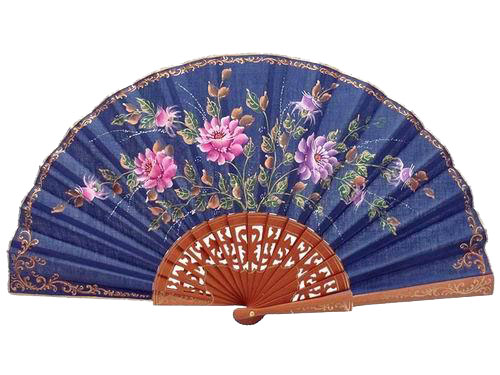
The manufacture of a fan
The manufacture of the fan requires the collaboration of several artistic categories: a painter to decorate and illustrate the body; an sculptor (ivory, bone, shell, nacre) or engraver (woods) to drill the rods; and in the most luxurious models a goldsmith (metals). With them also work different artisans that are in charge of manage the precise cut of the rods and the folding and pasting of the fabrics. The independence of each job makes it possible to create every part in different specialized workshops. The stages of the manufacturing process of a fan tends to be like this:
-
Cut of the rods, in parcels and with a template.
-
Polished, sanding and sharpening of the rods (one of the most delicate processes consist in sharpening the guide of the rods in the fabric area so it doesn't get bulky).
-
Draft of the rods with awls, using embossing and carving techniques.
-
If sculptors, graving artists and goldsmisths do a great job with the rods, the same happens with painters and its drawings, polychromy and golden of the body of the fan.
-
The manufacturing process its almost done when, grouped in packs of thirteen, sixteen or twenty four, and closed on the sides with two pleats, the whole thing is drilled on the bottom side, making a nail go through a hole and afterwards is riveted with two rosettes.
-
The body, whether it is made of paper, fabric, vellum or lace, is mounted on this skeleton. This materials can cover, on both sides, the rods or, in the case of the lace fans, just one of them. The fans without body, whose rods are attached together with zig-zag folded tape, recive the name of baraja. On this kind, the ivory ones of master artisans like the french Martain or the oriental types with silver decoration, have had a long tradition. The mechanization of the workshops has helped the production of the ivory fans, which before was a really delicate task. Not so the nacre ones, whose decoration has to be totally handmade since it doesn't admit a mechanic process.
It is known that before the folding fan showed up, some where already elaborated with lace and feathers. And in terms of the traditional folding type, it has suffered a long evolution and there has been diverse styles. In the XVI and XVII centuries, the wooden or ivory fan, with body made of fabric or embroidered kid, used to be of short flight. In the XVIII century the fan stop being an exclusive accesory of the upper class, and the wooden kind with short flight and reduced fabric became really popular. In the first half of the XIX century, the small ones from the empire era were really trendy. With the Romanticism they became bigger with a golden, decorating filigree, that was original from the pericón (big fans). In both eras it got imposed the novelty of the printed paper with engraving. On a parallel note, at the end of that century it was really frequent to use painted gauze and lace in the creation of big fans.
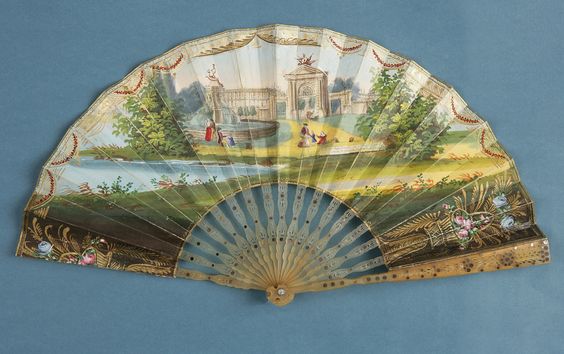
Spanish fans
The first master fan artisans known in Spain are from the XVII century: Juan Sánchez Cabezas, Juan García de la Rosa, Francisco Álvarez de Borja o Jerónimo García. Others that worked with them were painters like Duarte de Pinto y Juan Cano de Arévalo. The technical defaults of the spanish fans provoked that the production was exceeded at the end of the XVII century by french and italian manufacturers. The supremacy lost was not reestablished until the last quarter of the XVIII century, when Carlos II's government decided to subsidize this industry, bring a good master in this task from Italy and limit the entry to Spain of foreign fans. Under the protection of Floridablanca count, Eugenio Prost, french artisan, settled himself in Spain. He, with the help of his wife, put the spanish quality of the fans high enough to match the rest. Almost at the end of the XVIII century the fan masters artisans guild became official with the foundation of the Valencia Real Factory of Fans. Over time, slowly but surely, the fan became part of our culture. Used initially on the hottest days of the year to refresh the environment, became one of the most important parts of our tradition, specially in the flamenco field.
IMPORTANTE
In Flamencoexport we have a selection of artisanal fans, made by experts, decorated with a big variety of designs, and customizables. If you are interested in finding the perfect fan for you, visit our website and look at our main products.
Since la Feria de Abril is around the corner and it is only a month away, we are going to show you on our blog some of the novelties of this year, and a summary of some historic details and curiosities about the event, so we can start preparing for it and learn a little more about this really popular fiesta.
In terms of news, this year the biggest highlights are that la Feria will add one more day of fiestas and it will take place from the 30th of July to the 6th of May. This was approved at the end of last year through a municipal ordinance in order to take advantage of the touristic pull of the weekend. On the other hand, under the name 'Sevilla universal culture, between Murillo and the Expo of 92', the gate of the Feria de Abril 2017 will be dedicated to the fourth centenary of the painter's birth, and to the 25 years of celebration of the Universal Exposition. This will represent the bottle ovens of el Monasterio de la Cartuja, old clay factory of Pickman, and it will be flanked at the top by this two ovens with the orange bowl, the symbol of the Expo, above the arcs of el Paseo del Futuro of the universal exhibition.
IMPORTANT:
If you are thinking of visiting la Feria de Abril de Sevilla this year and you don't know what to wear, you can visit our web pages of Flamencoexport, where you would find beautiful flamenca dressess as well as short suits for guys and any other accesories you may need to finish your look.

La Feria de Abril, este año, se desarrollará del 30 de abril al 6 de mayo.
The castanets are a percussion instrument with centuries of history. Its origin goes back to the year 1000 B.C, specifically to the fenicians, an inminent commercial flourishing culture in the Mediterranean area countries: Greece, Turkey, Italy, Spain, etc. However, through history Spain has been the only one that has preserved and developped its use since then. The castanets are part of our cultural heritage, in fact, they are consider one of the national instruments. The castanets are often used to give color and spanish character to the music.
Its also a very recognizable instrument in flamenco dance and its made of all shorts of materials. The plastic castanets, usually cheaper and with less quality, make an strident noise when they are hit. But there exists also wooden ones, ebony, palisander or fiberglass, that are mostly used by professionals. This instrument is formed by two shells with two small ears that have perforated holes through which a cord is passed, to tie both parts.
Proper way of using the castanets
First, you have to ensure that each of the castanets has a differentiated sound, one is higher, the other lower. You have to put the one with the higher pitch in the right hand and the other one on the left. You have to put them in the thumbs of each hand, first the part that has the knot and then the other. It is very important that the castanets are well fitted to your thumbs, but they do not have to squeeze.
Position of the hands
To properly manage them is really important to position your fingers correctly. The right way to do it is putting the tips of the fingers faced and the palms turned to your body. The castanet of the right hand has to be played with the pinky and ring fingers, and middle and index fingers. In the left hand you have to play it with the middle, ring and pinky fingers at the same time.
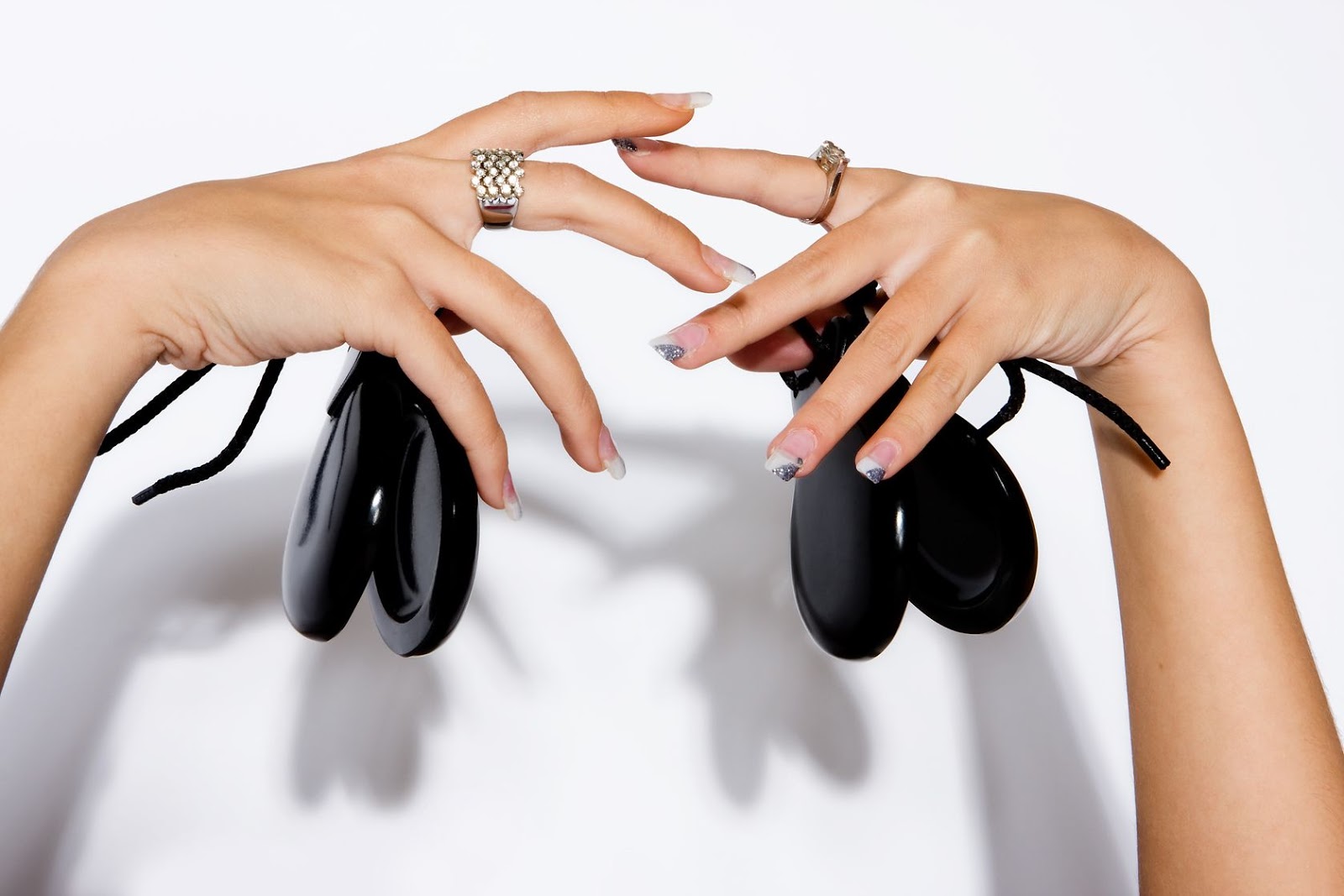
Rythm
The rythm has to start with the right hand, counting the last key with the sound of the left castanet. To achieve a good rythm is convenient to know that the sound of the castanets is based in different combinations of five independent elements.
-
CA-RRE-TI-LLA: This element is only used in the right hand. Trying to move the wrist as little as possible, you start to play the CA-RRE-TI-LLA, which consists of four strokes, CA, with the pinky; RRe, with the ring finger; TI, with the middle finger; LLA, with the index.
-
TAN: That is how it is called the stroke that you have to do after CA-RRE-TI-LLA. It is played with the ring and middle finger simultaneously, without any notice of different time in between the four strokes of CA-RRE-TI-LLA- and TAN , even though this last one is played a bit stronger.
-
TIN: This sound has to be heard after CA-RRE-TI-LLA-TAN. It is played with the ring and middle fingers of the right hand simultanously.
-
TIAN: This is how it is called when the sounds TIN and TAN sound together.
-
POSTICEO: This sound consists in the clash of the two castanets. In order to do it you have to bring your right hand to the left and clash them together.
IMPORTANT: If you are interested, here you can buy castanets from our web of Flamencoexport.

The fan, aside from becoming an indispensable part of the clothing of an era, constituted an ideal instrument of communication in a time where liberty of expresion for women was totally coerced. When the late XIX early XX century ladies went to the balls they were always accompanied by their mother or a maid, so they could look after the young woman's behavior. The maids were really strict with the tasks entrusted to them, so the ladies had to create a new way o communicating with their lovers and try to be unnoticed. That is why there were different fan languages, but all of them had a common rule, the placement of the object in the four directions with five different positions in each one. And with that system, they did represent each letter of the alphabet.








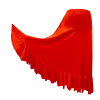
































 Wholesalers/Stockists
Wholesalers/Stockists Contact
Contact



